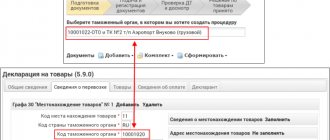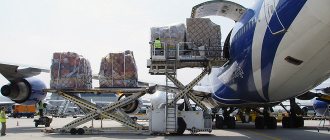Purpose
- Description of the peculiarities of cargo transportation - fragility, inadmissibility of ultraviolet light exposure, moisture ingress, etc.
- Description of the name of the goods, by which they can be easily found by both the consignee and representatives of the transport company.
More details about the purpose and design nuances:
Thanks to this, the risk of errors during delivery is practically eliminated, and time is also saved: a specific item can be found quickly enough.
NOTE. The obligation to draw up a document is determined by the specific situation. In most cases, a sheet is issued only if there are different items in the same package. If the shipment goes abroad, its presence is required.
In many cases, the presence of a document is a requirement of the shipping company, which needs it to quickly and correctly sort goods when sending them. Therefore, most often, drawing up a sheet is in the interests of the shipper himself .
Typically, the document is carefully packaged in a sealed file to prevent it from getting wet, lost, or damaged. It is placed in a special pocket, which is located on the side of the package (box, bag, etc.).
What is a packing slip for?
This document will be requested by the transport company to organize transportation. At customs it is necessary to carry out customs procedures. The form contains a description of the goods being transported, which affects the methods of their delivery. It will allow the carrier and consignee to quickly determine the contents of the package.
There is no official sample packing slip, so the company must determine its form itself.
Remember: the sheet is filled out by the sender before shipment.
Registration of transport documents
Get a free consultation
Call us on our toll-free number, or fill out the form and we will promptly contact you!
8 800 700 0952 Feedback
Form and sample 2021 - 2018
The completed form must always include the following information:
- Sheet number and date of its preparation.
- Official names of the companies of the seller, the buyer, and, if necessary, the shipper and consignee. In the case of private individuals, full name and passport details are indicated. In the case of legal entities, the full names and positions of authorized persons are additionally provided.
- A list of all shipped goods with a description of their essential characteristics (in each case determined at the discretion of the parties). The quantity, weight, unit of measurement, volume, and official name of the unit of cargo (goods) are always indicated according to the nomenclature or other documents.
- The exact address of the destination along with the region and zip code. If the destination address is located on the territory of another state, the address is usually written in both Russian and the language of that country (usually in Latin).
- Type of packaging - cardboard box, bag, pallet, wooden box, pallet and other items, depending on the classification adopted by the enterprise.
- The total number of places, the mass and volume of each place, the total mass and volume.
- Information about the employee who packed the goods and the person who checked his work: full name, position, signature.
Blots, corrections, strikeouts and other types of correction are not allowed. You can fill out the form either printed or handwritten. In the latter case, it is permissible to use a blue or black pen.
The number of copies depends on the number of parties involved in sending the cargo, its transportation and acceptance. Usually there are three participants:
- Shipper.
- Consignee.
- Transport company delivering cargo.
Accordingly, there are 3 copies in the original form, each of which has equal legal force.
You can use the following form as a basis:
And as a completed sample, use this option:
In this case, the document can be drawn up either on a regular A4 sheet or on the company’s letterhead.
NOTE. In the case of sending any cargo to a foreign partner, as a rule, it is necessary to draw up an invoice, which to one degree or another corresponds to the invoice for payment.
Invoice
An invoice is included in the mandatory documents for cargo transportation. An invoice may also be called an “invoice”. The invoice reflects the fact of the transaction between the seller and the buyer.
The invoice contains the name of the product, the quantity of each item, the price per unit, and the total amount to be paid.
Be sure to indicate the date, number, names and details of the buyer and seller.
Taxes payable are indicated separately.
The invoice may also indicate the terms of the transaction, terms and methods of payment and shipment.
An invoice is a key document for cargo transportation. An invoice is required during customs clearance of cargo.
The efficiency of customs clearance depends (entirely!) on how correctly the invoice is drawn up. It is important for the carrier that the invoice for the goods transported is drawn up accurately and correctly.
GOST
Since it is an official document that has a unique number in the OKUD system: 1002004. As for the regulatory reflection in documents, the registration regulations are described in different standards that are related to the rules of packaging and/or labeling of goods:
- GOST R 51474-99;
- GOST 14192-96.
The main essence of the requirements of the standards is that the marking necessarily reflects:
- so-called handling signs - special designations that indicate how the shipment should be handled (do not turn it over, do not throw it, etc.);
- warning notices - to provide additional information about the peculiarities of cargo transportation;
- main and additional records on information about the sender and recipient, number of pieces, cargo number in the shipment, net and gross weight.
The legislative framework
The rotation of the packing list is regulated by several legislative documents. Since paper is used for transportation both within the state and abroad, the main provisions are described in the Customs Code of the Customs Union. In addition, regulatory regulation is carried out by the following documents.
- Berne Freight Convention for Railway Transport of 1985.
- Geneva Convention for Road Transport of 1975.
- Warsaw Convention for Air Services of 1955.
- UN Multimodal Transport Convention 1980.
- Federal law relating to the control of the transportation of goods by road.
- Decrees of the Government of the Russian Federation.
Documents required for sending cargo
Recently, the rules for the provision of transport and forwarding services have undergone some changes. For example, since July 2021, amendments have come into effect that require private citizens and legal entities to provide certain documents when sending.
Individuals
If goods are sent by an individual, he/she must present:
- your passport;
- dispatch inventory, the form of which is issued by the transport itself class=”aligncenter” width=”658″ height=”558″[/img]
- a notarized power of attorney (if the citizen’s representative acts instead of him).
Legal entities
For any companies (commercial firms, charities, public organizations, religious societies), a set of the following documents is expected:
- Passport.
- A power of attorney for the actions of a company representative, which is certified by the manager or other authorized person. If the manager himself sends the goods, it is enough to provide a document confirming his appointment to the position.
- Document for the cargo: as a rule, this is a packing list, designed according to a random sample.
In some special cases, along with these papers, additional ones will be needed: characteristics of the cargo, permission to transport, etc. This is usually due to the special nature of the material assets - hazardous chemicals, biological samples, etc.
Before shipment of goods: label approval and certification
At the stage of signing a contract with a foreign supplier, it is important to discuss the form of packaging, information on the label and included instructions for the product. So, if the goods need to be marked and registered in the “Honest Mark” system, then this will require elaboration of the issue in advance. The manufacturer will have to purchase special equipment to print the identification code and integrate marking into the production process of the foreign plant.
Please contact your customs representative with product details and label. The company's specialists will evaluate the final layouts. The information on the label will be checked for compliance with customs control requirements. If you need to enter data, it will be easier to do this at the preparatory stage.
Check the label information
Check whether you need to obtain mandatory product certification and permits. For example, a product requires certification in accordance with technical regulations. Some certificates take more than a month to complete. Therefore, it is more convenient to first import samples for testing. To do this, draw up an agreement with the certification body and a letter with the specified number of samples. The customs representative will organize the transportation and correct customs clearance of the samples.
Before importing goods, obtain permits
Apply with Avangard Direct to entrust the verification of documents to professionals.
Determination of the number of packages
From the point of view of the transport company, the main information that should be contained in the packing list is related to the dimensions and weight of the shipment:
- number of seats;
- the mass of each place;
- volume of each place;
- total mass and volume;
- net and gross weight.
The number of packages is determined very simply: one package is equal to one piece . Packaging can mean different items:
- plastic bag;
- package;
- box;
- pallet, etc.
Therefore, if it is stated that the carrier accepted, for example, 10 pieces, this may indicate a variety of combinations - for example, 3 boxes, 2 bundles and 5 pallets. Therefore, 100 seats in one case will take up the volume of several trucks, while in other situations 1000 seats can fit into one truck.
Packaging selection
Papers, printed publications, small items weighing up to 3 kg can be packed in an envelope, plastic bag or thick paper, tying or sealing the wrapper.
Heavy and large items should be sent in a box, bag or lined with thick fabric.
Envelopes, boxes and other packaging materials can be purchased at post offices. For EMS shipments, EMS envelopes and plastic bags up to 60 × 70 cm in size are provided free of charge.
Items with an inventory of the contents should not be pre-packaged - they must be handed over to a Post Office employee to check the contents with the inventory and only then packaged.
Carrier liability
The responsibility of the transport company is governed by the relevant contracts of carriage. The duties of the carrier are described in the Civil Code (Article 796):
- loss of cargo, shortage;
- damage or deterioration.
At the same time, the application of liability in relation to the carrier is excluded if damage or loss of goods occurred for reasons that he cannot directly influence:
- Any circumstances related to the actions of the sender and/or recipient of the cargo.
- Special natural properties of an object. For example, if glassware is transported, but the sender himself did not take care of the correct packaging, additional protection of the item with soft cloth, the presence of warning signs on the container, as well as the corresponding mark in the cargo documents, representatives of the transport company cannot be held responsible.
- Defects in the packaging itself that cannot be detected by the carrier. For example, it is obvious that sharp objects cannot be packed in cardboard or a bag.
Certificate of Origin
The certificate of origin of the goods is included in the mandatory list of documents for cargo transportation.
Certificate of origin of goods is a document on a special form, with a description of the goods and confirmation from the government body that the goods for which the certificate of origin is issued were produced or processed in the country on behalf of which the specified government body acts.
The certificate of origin of the goods is issued by the chamber of commerce and industry of the country of origin. The recipient of this document is the supplier of the goods. The standard form is defined by the Kyoto Convention.
If documentary origin of the country of origin is required during customs clearance of goods, a certificate of origin of the goods is provided.
One state does not have the right to confirm the origin of a product produced in another country.
List of items prohibited for shipment
In Russian federation
- firearms, signal weapons, pneumatic weapons, gas weapons, ammunition, cold weapons (including throwing weapons), electric shock devices and spark gaps, as well as main parts of firearms;
- narcotic drugs, psychotropic, potent, radioactive, explosive, caustic, flammable and other dangerous substances;
- poisonous animals and plants;
- Russian banknotes and foreign currency;
- perishable food, drinks;
- items that, by their nature or packaging, may pose a danger to postal workers, stain or damage other postal items and postal equipment.
When imported into the territory of the Russian Federation
- Printed and audiovisual materials: containing calls for extremist and terrorist activities or public justification of terrorism; pornographic in nature; manufactured or distributed in violation of the requirements of the legislation of the countries of the customs union of the Eurasian Economic Community on elections and referendums; aimed at promoting Nazi paraphernalia or symbols or paraphernalia or symbols that are confusingly similar to Nazi paraphernalia or symbols; containing other information that may harm the political or economic interests of the Russian Federation, its state security, health and morality of citizens;
- any types of weapons (their parts), cartridges for them (their parts), products structurally similar to civilian and service weapons;
- hazardous waste;
- special technical means designed to secretly obtain information;
- toxic substances that are not precursors to narcotic drugs and psychotropic substances;
- narcotic drugs, psychotropic substances and their precursors, including in the form of medicines;
- human organs and (or) tissues, blood and its components;
- plants in any form and condition, plant seeds;
- live animals, with the exception of bees, leeches, silkworms;
- ozone depleting substances;
- plant protection products covered by Annexes A and B of the Stockholm Convention on Persistent Organic Pollutants of 22 May 2001;
- tools for extraction (catch) of aquatic biological resources:
- finished knotted fishing nets, produced machine- or manually from synthetic nylon or other polyamide monofilaments with a thread diameter of less than 0.5 mm and a mesh size of less than 100 mm (the size of the constructive mesh pitch is less than 50 mm);
- finished knotted fishing nets, produced by machine or manually from other synthetic monofilaments with a thread diameter of less than 0.5 mm and a mesh size of less than 100 mm (the size of the constructive mesh pitch is less than 50 mm);
- electrofishing systems and devices consisting of electrical signal generators, with connected conductors and an accumulator (battery), jointly performing the function of extracting (catching) aquatic biological resources through electric current);
- alcoholic products, ethyl alcohol, beer;
- any types of tobacco products and smoking mixtures;
- radioactive materials;
- cultural values;
- goods subject to rapid deterioration;
- precious stones in any form and condition, natural diamonds, with the exception of jewelry.
When exported from the territory of the Russian Federation
- Printed and audiovisual materials: pornographic in nature; manufactured or distributed in violation of the requirements of the legislation of the countries of the customs union of the Eurasian Economic Community on elections and referendums; aimed at promoting Nazi paraphernalia or symbols or paraphernalia or symbols that are confusingly similar to Nazi paraphernalia or symbols; containing other information that may harm the political or economic interests of the Russian Federation, its state security, health and morality of citizens;
- any types of weapons (their parts), cartridges for them (their parts), products structurally similar to civilian and service weapons;
- hazardous waste;
- special technical means designed to secretly obtain information;
- toxic substances that are not precursors to narcotic drugs and psychotropic substances;
- narcotic drugs, psychotropic substances and their precursors, including in the form of medicines;
- human organs and (or) tissues, blood and its components;
- waste and scrap of ferrous and non-ferrous metals;
- unprocessed precious metals, scrap and waste of precious metals, ores and concentrates of precious metals and commodities containing precious metals;
- mineral raw materials (natural unprocessed stones);
- information about subsoil;
- plants in any form and condition, plant seeds;
- live animals, with the exception of bees, leeches, silkworms, which are sent with a veterinary certificate;
- ozone depleting substances;
- alcoholic products, ethyl alcohol, beer;
- any types of tobacco products and smoking mixtures;
- radioactive materials;
- cultural values;
- goods subject to rapid deterioration;
- precious stones in any form and condition, natural diamonds, excluding jewelry
List of items prohibited for shipment by airmail
- Firearms, signal, pneumatic, gas weapons, components of firearms, signal, pneumatic, gas weapons, ammunition, dummies of such items, including unloaded grenades, shells and other similar objects, edged weapons (including throwing weapons), all types of knives, electric shock devices.
- Narcotic drugs, psychotropic substances and their precursors.
- Explosives and products containing them. Example: TNT, heating element, nitroglycerin, ammonal, granitol, dynamite, hand grenades, rockets, shells, ammunition, detonators, detonator caps, gunpowder, fireworks, pyrotechnic compositions, small arms cartridges.
- Flammable, toxic and non-flammable and non-toxic gases and products containing them. Example: gas lighters, compressed and liquefied gases in cylinders, hydrogen, propane, butane, varnishes and deodorants in aerosol packaging, carbon dioxide, fire extinguishers, chlorine, mustard gas.
- Flammable liquids and products containing them. Example: gasoline, kerosene, solvents, acetone, varnishes, oil paints, nitro enamels, primers, removers, sealants, ethers, adhesives based on organic solvents, cosmetic lotions, colognes, perfumes, eau de toilette, nail polishes, fir oil.
- Flammable solids and products containing them. Example: matches, sulfur, any metal powders, coated aluminum powder, magnesium, sparklers, white and yellow phosphorus, napalm, coal, calcium carbide, sodium.
- Oxidizing substances, organic peroxides and products containing them. Example: ammonium nitrate fertilizer, ammonium nitrate, potassium nitrate, calcium chlorate, bleaches, hydrogen peroxide, some hardeners.
- Toxic (poisonous) substances and products containing them. Example: arsenic, nicotine, cyanide, pesticides, strychnine, bromoacetone.
- Infectious substances and products containing them. Example: diagnostic samples, biological products, rabies virus, clinical and medical waste.
- Radioactive substances and products containing them. Example: radionuclides, isotopes.
- Corrosive substances and products containing them. Example: electrolytes for batteries, mercury, sulfuric, hydrochloric, acetic and other acids, caustic soda.
- Other hazardous substances and products containing them. Example: lithium batteries, dry ice.
Guidelines for the acceptance of international postal items (IPO)
It is prohibited to use metal boxes and crates, foil, metallized paper and fabrics for packaging.
Check out the parcel











